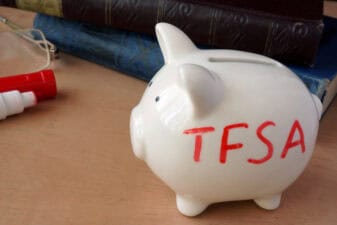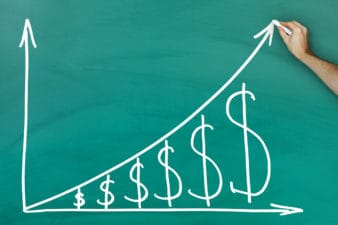Take Stock is the Motley Fool Canada’s free investing newsletter. To have future editions delivered directly to you, simply click here now.
Dear Fellow Fools,
There is perhaps no better way to get paid on a regular basis than investing your hard-earned savings into a collection of dividend-paying stocks. This is a strategy that we Fools have been long-time proponents of.
However, not all dividend-paying stocks are created equally.
In this week’s Take Stock, we take a look at three things you need to keep in mind before diving into that next seemingly attractive dividend-paying entity.
The basics
At the most basic level, dividends are cash payments made to the owners (aka you and me) of a company. Not only do dividends provide owners with a regular payout, they are also meant to symbolize a periodic indication from management and the board that all is well within the company.
Dividend payers are not all that uncommon. A full 57 of the 60 firms that comprise the S&P/TSX 60 – a collection of the 60 biggest public companies in Canada – currently pay a dividend. (56 if you consider Kinross Gold (TSX:K,NYSE:KGC) last week said it intends to skip its next dividend payment, but has not cancelled the program outright.)
However, as evidenced by the Kinross suspension, as well as the 75% cut that fellow gold miner Barrick Gold (TSX:ABX,NYSE:ABX) announced last week, the quality of these dividend payers varies significantly.
Just like in high school, running with the wrong crowd of dividend stocks can have negative implications for the health of your portfolio. When a company cuts or suspends its dividend, not only does a decrease in dividend income occur, but it also typically leads to a decline in the company’s share price. That’s a double-whammy for investors and something we’d like you to avoid.
Here are three items that dividend investors should watch for to avoid taking such a hit.
1. Free cash flow
As indicated, dividends are cash payments made from a company to its owners. The key word here is cash. This cannot be stressed enough. The company needs cash to make its dividend payments.
Therefore, to determine whether a company will be able to service its dividend through thick and thin, go straight to the Statement of Cash Flows. From here, the figures to concentrate on are cash flow from operations (CFO) and capital expenditures (cap ex). If we subtract cap ex from CFO, we’re left with the company’s free cash flow — three of the sweetest words a Fool can hear.
Free cash is what’s left for shareholders after the company has taken care of all of its other commitments. This excess cash can be returned to shareholders through dividends or share buybacks, used to pay down debt, or kept on hand to either save for a rainy day or reinvest in high-returning (ideally) growth initiatives.
If a dividend-paying company is not able to demonstrate that it can consistently generate free cash over multiple periods (crucial), that company’s dividend cannot be trusted.
Let’s look at Barrick and Kinross as prime examples. The table below provides their total free cash generation over the past five years, as well as their total dividend payouts.
| Company |
Total Free Cash |
Total Dividends |
| Barrick Gold |
-$3,949.0 |
$2,413.0 |
| Kinross |
-$474.5 |
$491.6 |
Source: Capital IQ. Amounts in millions.
See those negative signs in the Total Free Cash column? Given the huge cap ex required in the gold mining industry, as well as the unpredictability of the commodity, these companies were ill-suited to not only be dividend payers but dividend growers, as both increased their payouts over this period.
Free cash flow for each over this five-year period should have at least matched the total dividends paid — ideally, it would have exceeded it. If this had been the case, last week’s cuts/suspensions would not have occurred.
2. Balance sheet
For even more insight into a company’s ability to pay/maintain/grow its dividend, we now turn from the cash flow statement to the balance sheet. Nothing can sink a dividend payer’s ship faster than a weak financial position.
You see, although dividend payments represent an obligation to shareholders, debt-related payments come first. That is, before a company can make a dividend payment, it has to ensure that it’s able to cover its interest payments and either refinance or pay down any debt that may be maturing. Where missing a dividend can result in a hair-cut for the company’s stock, missing a debt-related obligation can result in the company’s death.
Not to pick on Barrick and Kinross, but they really do serve as poster children for what we’re looking at here. Take a peek at the following table, which shows the trajectory of total debt for each over the past five years.
|
Barrick Gold |
Kinross Gold |
|||
| Year |
2008 |
2012 |
2008 |
2012 |
| Total Debt |
$4,556.0 |
$13,943.0 |
$950.9 |
$2,632.6 |
Source: Capital IQ. Amounts in millions.
Not only did both companies take on debt to fund ambitious expansion through the teeth of the bull market, but, because of their free cash deficiencies, they had to borrow cash (there’s that word again) to fund their dividend.
This combination of negative free cash and a rapidly escalating debt profile may work for a while, but is not sustainable over a long period of time. Watch for it! It’s much more prevalent than it should be, especially in the Canadian market.
3. Shabby track record of dividend payouts
If you come across a dividend payer that’s piqued your attention and you don’t want to go through the effort of looking into five years of free cash flow or balance sheet-related history, there is a quicker and dirtier approach to gauge the quality of that dividend.
Simply, look at that company’s historical record of dividend payouts on a per-share basis.
You can recognise the potential bad apples fairly easily by looking at their five- and ten-year history of dividend payouts. Sometimes it’s obvious – a past dividend cut or suspension – but other times it can appear more innocuous. An example could be where a company hasn’t raised its payout at all, despite solid earnings growth. In either case, these have been shown to be red flags and companies with shoddy dividend track records appear prone to changing the dividend policy if business turns bad.
The Foolish bottom line
A great dividend is a lasting and growing one – and if you find a company that offers both, there’s a good chance it’s a company you’re going to want to buy and hold for a long time. These companies may not offer the flashy short-term capital appreciation that draws the attention of the media and mainstream market participants, but over the long term, you’ll be shocked at the total returns that these names are capable of providing. In risk-adjusted terms, it’s not even a contest.
Remain vigilant however and consider all three of these items before you jump into your next dividend stock.
Be sure to follow us on Twitter and Facebook for the latest in Foolish investing.
‘Til next time … happy investing and Fool on!
Sincerely,
Iain Butler
Senior Analyst
The Motley Fool Canada








